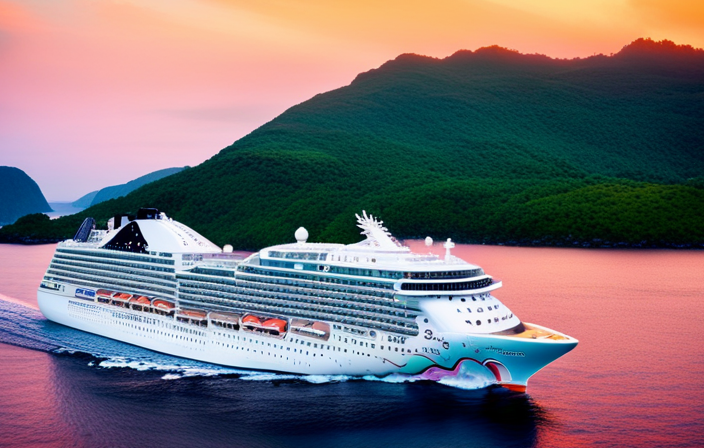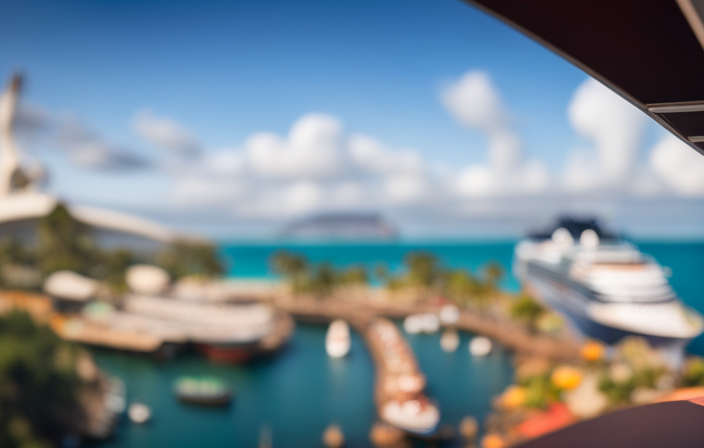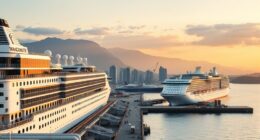As an individual fascinated by the intricacies of cruise ships, the concept of dry dock intrigues me. It acts as a restorative transformation for these majestic vessels, providing the essential upkeep and care to keep them in pristine condition.
Dry dock is a process that allows cruise ships to undergo necessary maintenance, repairs, and renovations in a controlled environment. It’s where the ship is temporarily removed from the water, allowing experts to inspect every nook and cranny, and make any necessary upgrades.
From the moment the ship is lifted out of the water to the final touches before it’s ready to sail again, the dry dock process ensures that every aspect of the ship is thoroughly examined and improved.
In this article, we will delve into the world of dry dock for cruise ships, exploring its purpose, the steps involved, and the benefits it brings to these floating wonders of the sea.
Key Takeaways
- Dry docking is a crucial maintenance process for cruise ships that involves extensive repairs, thorough inspections, and renovations.
- The length of time for dry docking is determined by factors such as the extent of repairs required, size of the vessel, scheduling conflicts with the shipyard, and the need for suitable maintenance period.
- Dry docking increases the lifespan of cruise ships by up to 20% and ensures compliance with international regulations and standards.
- Dry docking enhances passenger experience through renovations and upgrades, maintains optimal performance of cruise ships, and enhances safety and sustainability.
Definition and Purpose of Dry Dock for Cruise Ships
A dry dock is a large basin that can be filled with water and then drained for ship maintenance and repairs. It provides a controlled environment for work to be done on the ship’s hull, propellers, and other underwater components. The ship is taken out of the water and placed in the dry dock, allowing for thorough inspections, cleaning, painting, and repairs that are difficult to perform while the ship is in the water. This process ensures the ship’s safety and structural integrity while minimizing the environmental impact. Regular dry docking is crucial for the maintenance and repairs of cruise ships, ensuring their longevity and continued safe operation.
Importance of Regular Maintenance and Repairs
Regular maintenance and repairs are essential for the smooth sailing and impeccable grace of a majestic ocean traveler, like a soothing spa treatment. Cruise ships operate in a harsh marine environment, constantly facing wear and tear. Without regular maintenance, these vessels would deteriorate quickly, posing safety hazards and operational inefficiencies.
Regular dry docking allows for the prompt identification and resolution of damages or issues, preventing them from escalating into more significant problems. This proactive approach ensures the ship’s longevity and enhances its performance, fuel efficiency, and passenger comfort.
Furthermore, conducting regular maintenance and repairs during dry dock periods is more cost-effective compared to addressing issues as they arise. By properly maintaining a cruise ship, it can continue to provide an unparalleled experience to its passengers.
Transitioning into the subsequent section, let’s explore the meticulous process of preparing a ship for dry dock.
Process of Preparing a Ship for Dry Dock
The meticulous process of readying a vessel for its scheduled maintenance involves thorough inspections, planning, and execution. The process steps for preparing a ship for dry dock include:
-
Initial assessment: Conducting a detailed inspection of the ship’s hull, machinery, and equipment to identify any maintenance or repair needs.
-
Planning and scheduling: Developing a comprehensive plan that outlines the scope of work, required resources, and a timeline for the dry docking process.
-
Cost estimation: Ensuring proper budgeting for the dry docking project by accurately estimating the costs of labor, materials, and any additional services or equipment needed.
By following these steps, shipowners and operators can effectively prepare their vessels for dry dock maintenance.
The next section will explore the various dry docking facilities and equipment available to support this important process.
Dry Docking Facilities and Equipment
With state-of-the-art facilities and cutting-edge equipment at my disposal, I have the ability to provide top-notch dry docking services for cruise ships. Dry dock facilities are specifically designed to accommodate the large size and weight of these vessels.
The docking area is equipped with heavy-duty cranes, hydraulic lifts, and a variety of specialized tools to ensure a smooth and efficient process. The dry dock equipment includes dry dock gates, which create a watertight enclosure around the ship, allowing it to be drained of water. This enables me to access and inspect the ship’s hull and other critical components.
Additionally, the facilities have workshops equipped with advanced machinery for any necessary repairs or maintenance.
Transitioning into the next section about the inspection and assessment of the ship’s condition, I carefully examine every aspect to ensure its seaworthiness.
Inspection and Assessment of the Ship’s Condition
When you step aboard, you’ll assess the ship’s condition to ensure its seaworthiness. This inspection is crucial before any work can begin during dry dock.
To effectively assess the ship’s condition, various inspection techniques are employed. These techniques include visual inspections, ultrasonic testing, and magnetic particle testing.
Visual inspections involve a thorough examination of the ship’s structure, looking for signs of corrosion, cracks, or other damages.
Ultrasonic testing is used to detect hidden defects by sending high-frequency sound waves through the ship’s structure and analyzing the echoes.
Magnetic particle testing is used to identify cracks and other surface defects by applying a magnetic field and using iron particles to highlight any abnormalities.
Once the ship’s condition has been assessed, cost estimation is performed to determine the budget required for repairs and maintenance. This includes calculating the costs of materials, labor, and any additional resources needed.
Transitioning into the subsequent section about the scope of work during dry dock, it is crucial to understand the ship’s condition and the estimated costs in order to plan and execute the necessary repairs and maintenance effectively.
Scope of Work during Dry Dock
The shipyard services provided during dry dock are crucial for maintaining and improving the condition of a cruise ship. The process begins with the ship being brought into the dry dock facility, where it is secured and prepared for inspection and assessment.
Once the ship is in position, various dry dock procedures are carried out, including hull cleaning, painting, and repairs. This involves thorough inspections of the ship’s structure, systems, and equipment to identify any issues that need to be addressed. Shipyard workers meticulously carry out repairs and replacements as necessary, ensuring that the ship is in top-notch condition.
These dry dock procedures are essential for ensuring the safety and longevity of the ship.
Moving on to renovations and upgrades during dry dock, various enhancements are made to improve the ship’s facilities and amenities.
Renovations and Upgrades during Dry Dock
During renovations and upgrades, the vessel undergoes a stunning transformation, with new and improved facilities and amenities. This process involves a wide range of renovations and upgrades to enhance the passenger experience and keep the ship up to date with the latest trends and technologies.
Here are the key areas that are typically focused on during dry dock:
-
Accommodations: Upgrading cabins with new furniture, fixtures, and decor to create a more modern and comfortable environment for guests.
-
Public Areas: Renovating lounges, restaurants, and entertainment venues to provide a fresh and appealing atmosphere.
-
Technology: Installing state-of-the-art systems for communication, navigation, and entertainment to enhance the overall guest experience.
These renovations and upgrades ensure that the cruise ship remains competitive in the industry and meets the expectations of modern travelers.
Moving on to safety measures and environmental considerations, it is crucial to address these aspects to ensure the well-being of passengers and the protection of the environment.
Safety Measures and Environmental Considerations
To ensure your safety and protect the environment, it’s important to implement stringent safety measures and environmentally-friendly practices during the dry dock process.
Safety regulations play a crucial role in preventing accidents and ensuring the well-being of the crew and passengers. This includes thorough inspections of the ship’s structure, equipment, and systems, as well as training programs for the crew on emergency procedures.
Additionally, environmental impact is a major concern during dry dock. By reducing fuel consumption by up to 20% through the use of energy-efficient technologies, cruise ships can minimize their carbon footprint. Advanced waste management systems are also implemented to properly handle and dispose of waste materials, mitigating any negative impact on the environment.
Transitioning to the next section, the length of time for dry docking is another important aspect to consider.
Length of Time for Dry Docking
The duration of a ship’s maintenance period in dry dock can feel like an eternity, but it’s a necessary sacrifice for ensuring the safety and sustainability of our seafaring adventures. When determining the length of time for dry docking, several factors come into play.
-
Extent of repairs: The more extensive the repairs required, the longer the ship will need to stay in dry dock. This includes everything from routine maintenance to major renovations.
-
Size of the vessel: Larger ships typically require more time in dry dock due to their size and complexity. The shipyard needs sufficient time to access all areas of the vessel and complete the necessary work.
-
Scheduling conflicts: Sometimes, there may be conflicts with the shipyard’s schedule or availability, which can impact the length of time for dry docking. Ship operators must work closely with the shipyard to find a suitable timeframe for the maintenance period.
In conclusion, while the length of time for dry docking can be significant, it is essential for ensuring the safety and longevity of cruise ships.
[Transition to the next section: Now that we understand the time commitment involved, let’s explore the benefits of dry docking for cruise ships.]Benefits of Dry Docking for Cruise Ships
One fascinating statistic to consider is that cruise ships can increase their lifespan by up to 20% through regular maintenance periods in dry dock.
Dry docking provides numerous benefits and advantages for cruise ships. Firstly, it allows for thorough inspections and repairs of the ship’s hull, propellers, and other crucial components that are exposed to constant wear and tear. This ensures that any potential issues are addressed promptly, preventing major problems in the future.
Secondly, dry docking offers an opportunity for cruise ships to undergo renovations and upgrades, enhancing the onboard experience for passengers. This may include adding new amenities, improving safety features, or upgrading technology systems.
Lastly, dry docking allows for compliance with international regulations and standards, ensuring that cruise ships meet all necessary requirements for operation.
Overall, dry docking is essential for maintaining the longevity and optimal performance of cruise ships.
Frequently Asked Questions
How often does a cruise ship typically undergo dry docking?
Cruise ships typically undergo dry docking every 2-5 years for maintenance. The dry docking process timeline involves bringing the ship to a designated facility, draining water, and performing inspections, repairs, and upgrades necessary to ensure safe and optimal operation.
What are the potential risks or challenges involved in the dry docking process?
During the dry docking process, there are several potential risks and challenges. These include structural issues, such as hull damage or corrosion, as well as logistical challenges like coordinating repairs and maintenance within a limited timeframe.
Can passengers stay on board during dry docking?
Passengers cannot stay on board during dry docking due to the extensive work and logistical planning involved. Passenger accommodations are not available as the ship undergoes maintenance, repairs, and inspections.
Are there any specific regulations or guidelines that govern the dry docking of cruise ships?
There are specific regulations and guidelines that govern the dry docking of cruise ships. These rules ensure safety, efficiency, and environmental protection during the maintenance and repair process.
How much does a typical dry docking operation cost for a cruise ship?
A typical dry docking operation for a cruise ship can cost anywhere from several hundred thousand dollars to several million dollars. It is an essential part of cruise ship maintenance, ensuring the ship’s integrity and functionality.
How Do New Rules for Cruise Ships Affect Dry Docking Processes?
The implementation of the new rules for cruise ships has significantly impacted the dry docking processes. Ships now have to undergo rigorous inspections and comply with stricter environmental and safety standards. This has led to longer and more complex dry dock periods, as cruise lines work to meet the new regulations.
Conclusion
In conclusion, dry dock for a cruise ship is an absolutely crucial process that ensures the ship’s longevity and top-notch performance. It’s like a magical rejuvenation chamber where the vessel undergoes meticulous inspections, repairs, renovations, and upgrades.
The facilities and equipment used are state-of-the-art, guaranteeing precision and efficiency. During dry dock, the ship becomes a masterpiece, with every detail fine-tuned to perfection.
It’s a safety net, protecting both passengers and the environment. So, rest assured, when a cruise ship undergoes dry dock, it emerges as a majestic and flawless marvel of engineering.
Alfons is the visionary leader and driving force behind Voyager Info’s success. As the Editor in Chief, he brings a wealth of experience and an unwavering passion for travel to the helm of our cruise-centric platform.
With a lifelong fascination for exploring new horizons, Alfons discovered his love for the ocean and cruising at a young age. From sailing across pristine Caribbean waters to embarking on daring expeditions to far-flung destinations, he has amassed a treasure trove of first-hand experiences in the world of cruising.











